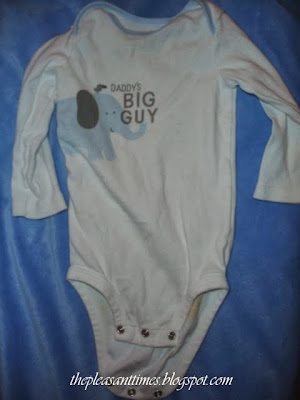Here is a quick way to make your own clothing extender for baby clothes. This is a little item that lets you get more wear out of the onsies that baby has outgrown in length. Besides that, I'm sure most mothers have noticed the discrepancy in baby clothes sizes -- sometimes an 18 month size onsie in one brand is a good 4 inches shorter than a 12 month in other brands! This "rescues" those kinds of clothes so you can use them after all. Baby clothes extenders can be purchased ready made, but they are sometimes expensive, and this is really a quick and easy method to make them!
Editor's Note: there are two methods shown. One uses another of the same type of garment (a onsie) and the other uses other kinds of baby clothing.
Method One: Using an extra out-grown onsie.
For an easy clothing extender, find another item of old baby clothing that you can sacrifice that has the same size snaps as the one you want to extend. Another onsie is ideal. If you are thinking ahead or making something for a mother-to-be, try finding stained baby clothing in a garage sale or thrift shop. Mothers of many can go through the old baby clothes stash. It doesn't matter so much what the rest of the garment looks like, you just want the part with the snaps to be in good shape and several inches around it to be stain-free.
With this onside, I will use the top part as a shirt, and turn the bottom snaps into a clothes extender (recycling 2 items out of one!).
Cut the onsie a little above the leg-holes, maybe an inch to and inch-and-a-half. You want to leave enough room to hem the shirt and have it be a decent length, but enough material in the snap part. I used a ruler to make sure I cut straight. Before you do this, snap the bottom of the onsie together.
Hem up the bottom of your new shirt!
With the bottom part, cut a line down as shown, to the leg hole binding, but not through it. Cut away excess fabric, leaving the binding in-tact. You want some of it still connected to the bottom snap-part of the fabric.
Cut through the side-seams of the binding.
It should look like a very strange sea-creature when you are done with it. The binding will make it really easy to make a sturdy, nice looking edge.
Take the binding and scoot/twist/sort of fold it up to the side of the extender. Overlap/Lay it over the side about 1/4 inch.
Stitch the binding on to the sides of the extender, using a straight stitch or zig-zag. Trim it up. The knit should not ravel, and so stitching on top of the binding through to the material should be sufficient.
Now fold the extender in half, right sides together. Stitch together at the top. You can decide how long you need this extender-- usually 3-5 inches would be long enough. After you stitch the top, open it up and see how long it is. You can stitch it again to make it shorter, and then trim and zig-zag the edge to neatly finish.
Here is what it should look like when you are done! One set of snaps should be up, and the other set down.
Here is it on another onsie. I have noticed that different brands and sizes of baby clothes have different size snaps, so one extender may not work for everything in the baby's wardrobe. Tucked into baby's little pants, no one will see the extender, and you got to use that cute little outfit a while longer!
Method 2: When you can't find another onsie or need different size snaps and don't want to go searching for another onsie:

Here we have a sacrificial baby gown, and a onsie. Another onsie would have been better, but this was the best I could find for a quick demonstration. (I know, I know, the baby gown looks perfectly fine--it was stained, and at the time I didn't know how to get old spit up stains out. Don't worry-- I'll use the rest of the gown for a doll dress or something! This is recycling!)
This is the part we want-- it's close to the neck ribbing so we'll get as close as we can. You want to keep this all snapped up while you cut it out.

Cut out around the the snaps in a rectangular shape, leaving about 3-4 inches on two sides (the left and right above), and ideally an inch next to the snaps. It makes it easier to trim down and hem properly if you have more room next to the snaps than I did! If you can cut it out neater than this on first try, congratulations. Others will have to try and trim up the edges to be smooth. Now lay the piece out just as you see above, don't move it, keep it snapped up.

Now fold it in half, right sides together. You will be sewing together the raw edges (shown on the right).

Sew or serge those raw edges together. If you are sewing instead of serging, go over them again with a zig-zag.

For the rest of the raw edges on the sides of the snaps, if you have enough material on those sides to hem them, do that; but if not you can zig-zag them like I had to. (If this is a gift, do try to get a big enough piece to hem, or serge it-- it looks nicer in presentation!)
Now to use it! Simply snap it to the onsie and you have a lot more use out of the garment! A set of these in graduated lengths and various snap sizes will be very handy-- busy mothers can make them in minutes, and they make a very thoughtful and useful gift for a mother-to-be!














